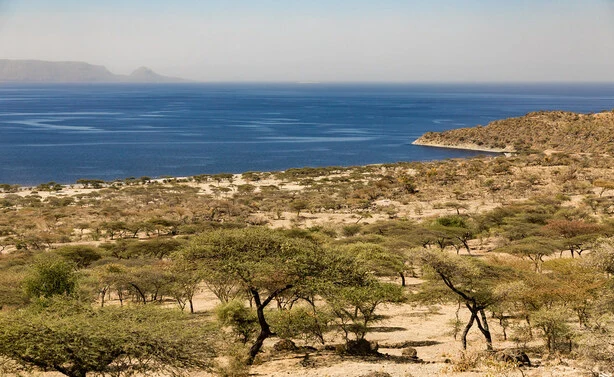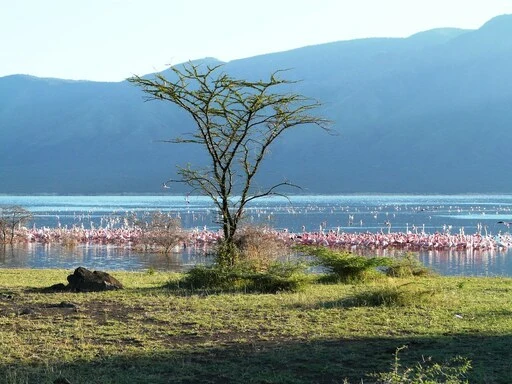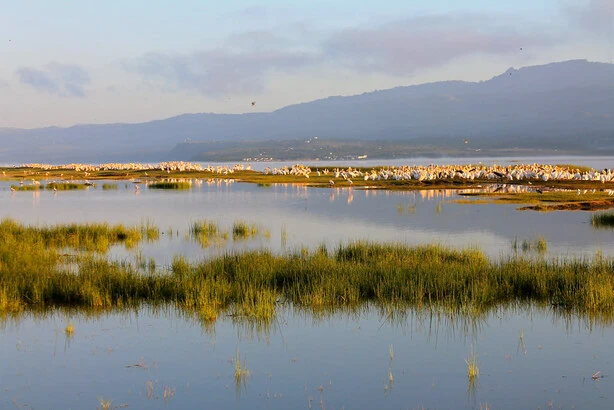The beauty of Africa can be easily painted using different colors; the wild animals, coastal regions, the rich African culture and the lakes in Africa, among other facets. The marine areas of Africa continue to attract more tourists onto the continent.
Apart from the coastal region encircling Africa, 677 lakes dot Africa, with 88 of them having been categorized as principal lakes, according to the World Lake Database. Lakes Victoria, Tanganyika and Malawi rank as the largest lakes in Africa.
The Rift Valley Lakes refer to a string of lakes within the East African Rift Valley, running through Eastern Africa, from Ethiopia, the Rift’s north to Malawi, the Rift’s south. This article discusses some facts commonplace with the different Rift Valley lakes of Africa.
1. Lake Shala

Also spelled Shalla, is located in south-central Ethiopia. It is 16.2 miles (26 kilometers) long and 7.5 miles (12 kilometers) wide. It is a saline/salty lake, with its maximum depth being 266 meters. Lake Shala is the deepest salty lake in Ethiopia. Its crater, the largest in Ethiopia, is famous for the vast birdlife found in the Abijatta-Shalla Game Park. Erosion and Earthquakes have since filled the ground around Lake Shalla with cracks.
The lake is enveloped by hot springs full of boiling water. The collection of steamy-hot springs is a major tourist attraction; people gather there to cook and bathe. Sulfur springs therein produce steam, making the area surrounding the lake usually foggy. Great white pelicans, including the Pelican Island, find habitat around the lake.
2. Lake Abijatta

Located within Abijatta-Shalla National Park, south of Addis Ababa in Ethiopia, trailing 10.6 miles (17 kilometers) long and 9 miles (15 kilometers) wide, Lake Abijatta is one of the saline lakes in Ethiopia. It has a 14-meter maximum depth. The lake is famous for the soda ash mining, which produces over 20,000 tons annually and its belly is projected to have over 460 million tons of soda ash, with lakes Chitu and Shala included.
With the lake neighboring Lake Shalla, it has several hot springs too, along its northeastern corner. These form a major tourist attraction site. Thousands of flamingos flock the lake, adding to its aesthetic value.
3. Lake Ziway

Also called Hora-Dambal, this is one of the fresh-water lakes in Ethiopia’s Rift Valley. It goes 9 meters deep as the maximum depth, 19.3 miles (31 kilometers) long and 12.4 miles (20 kilometers) wide and its surface area is 170 square miles (440 square kilometers). Lake Ziway is famed for the myriad bird species it homes and large herds of hippopotamuses. It is appreciated for significantly supporting Ethiopia’s fishing industry.
Approximately 2454 tons of fish are caught from the lake annually, which is projected to contribute 83% of Ethiopia’s fish production for a sustainable amount. This is according to the Ethiopian Department of Fisheries and Aquaculture.
Two rivers, River Meki and River Katar, feed the lake, while River Bulbula drains it, emptying the lake’s waters into Lake Abijatta. Interestingly, the lake has five islands, one of which is said to be home to a monastery or religious community which during the ninth century kept the biblical Ark of the Covenant.
4. Lake Turkana

Found in Turkana, Kenya’s northern region, this ranks as the most saline lake among the large lakes in Africa and all lakes globally. It is 180 miles (290 kilometers) long, 19.8 miles (32 kilometers) wide and 30 m in average depth. Lake Turkana is the largest permanent desert lake on earth and is the fourth largest saline lake by water volume in Africa.
It is a major breeding lake for Nile crocodiles, poisonous snakes and hippos. With evidence of numerous hominid fossils discovered around Lake Turkana, the area has been named as the cradle of humankind and serves as a set-apart laboratory for studying animal and plant populations.
The Lake is said to be currently endangered by the construction of Ethiopia’s Gilgel Gibe III Dam. The construction is set to dam Omo River, which is a major water supplier to the lake. Water from the lake is not safe for either drinking or crop irrigation, due to its high alkaline levels.
5. Lake Baringo

Next to Lake Turkana is Lake Baringo to the north, also within the Rift Valley. It is 13 miles (21 kilometers) long, 3.1 miles (5 kilometers) wide and its maximum depth is 5 meters. It is a freshwater lake, though with no obviously visible outlet. The waters are thought to seep down the lake’s sediments into the underlying faulted volcanic bedrock.
It is home to numerous wild animals such as hippos, Nile crocodiles, seven fish species and other kinds of animal species. Over 500 bird species are also found breeding within the lake and its surroundings. Most of the migratory birds have their stop-over here while on their journey within and outside Africa.
Lake Baringo has a number of small islands; the largest of them is Ol Kokwe Island. This island has several hot springs and fumaroles. In 2021, the government reported a water increase of over 100%, spanning to 103.6 square miles (268 square kilometers).
6. Lake Bogoria

Stretching 11 miles (17 kilometers) long and 2.5 miles (4 kilometers) wide and with a maximum depth of 8.5 m, Lake Bogoria is another lake in Kenya’s Rift Valley. It is a saline and alkaline lake, with the water getting saline through the high evaporation witnessed in this semi-arid territory. The lake’s salty levels are twice that of seawater.
Geysers and hot springs are a famous phenomenon within the lake. They are distributed in four spots around the lake and generally, they can erupt 5 meters high.
Lake Bogoria has the highest recorded concentration of real geysers in the whole of Africa. Massive flamingo numbers are also recorded there, feeding algae and drinking fresh water from the lakeside’s streams. Fish cannot survive there.
7. Lake Naivasha

Another Rift Valley lake in Kenya is Lake Naivasha. It is located less than 1.86 miles (3 kilometers) from Naivasha town. It is a freshwater lake running 5m deep and is 8 miles (13 kilometers) wide. It provides the best view of wildlife such as the Colobus monkey, huge numbers of hippos and very high flamingo populations. Over 1500 hippos call it home and more than 400 bird species found around the lake make it a bird’s paradise.
Within the vicinity of the lake are two other lakes, Lake Sonachi (a greenish crater lake) and Lake Oloiden. The lake’s water volumes remain uneven, with the lake’s history showing the sequential drying and flooding of the lake.
8. Lake Elementaita

This 11.2 mile (18 kilometers) long lake, with a shallow depth of between 0.9 and 1.5m, is another Rift Valley lake. It is visibly different from all others, having bright pink water. This color is said by ecologists to emanate from a pink pigment commonplace in algae. The lake has huge populations of flamingoes and when the flamingos eat this algae it gets digested and absorbed. The pigment then makes the flamingo skin and feathers pink.
The shores of the lake are breeding spots for gazelles, eland, zebras and warthogs, among many other wild animals. It is also a sanctuary for the hard-to-find Rothschild Giraffe and the threatened colobus monkey. The lake is part of the Soysambu Conservancy.
9. Lake Nakuru

This lake’s maximum depth is 1.8m and it is located south of Nakuru town, surrounded by Lake Nakuru National Park. Large flamingo numbers, bird species, warthogs, southern white rhinos and eastern black rhinos are some of the wild animals you would see there.
Between 2010 and 2020, the lake’s surface area under water increased from 15.4 to 26.4squre miles (40 to 68 square kilometers), flooding several kilometers of Nakuru Town and Nakuru National Park. The Ramsar Convention provides protection to the lake.
10. Lake Magadi

Saline, alkaline and running approximately 39 square miles (100 square kilometers), Lake Magadi is 20 miles (32 kilometers) long. Over 80% of the lake is covered with soda ash especially during the dry season. In some places, the salt goes up to 40 meters thick. The lake is famed for the many birds hovering around it and its environs.
Flamingoes are some of the birds you would spot there, among over 100 bird species commonplace with the lake. The Wailing Cisticola, Red-throated Tit, African Bare-eyed Thrush and the Black-necked weaver are some of the birds you would easily spot within the lake’s environs.
Saline hot springs, with temperatures weighing above 176 degrees Fahrenheit (80 degrees Celsius), discharge the water into lagoons around the lake’s margins, which then recharge the lake. Only a single fish species survives there- the cichlid Alcolapia grahami and can be spotted in some of the hot spring pools on the lake’s shoreline.
11. Lake Tanganyika

Lake Tanganyika is located between Tanzania and Congo. It has a surface area of 11390 square miles (32900 square kilometers) and goes over 1400 meters deep. It is the largest and deepest lake among the Rift Valley lakes and ranks second globally. Siberia’s Lake Baikal takes the fame of being the deepest.
Stretching for 11744 miles (18,900 kilometers), Lake Tanganyika is the longest freshwater lake on earth. It is also the second-largest by volume and second-oldest freshwater, after Lake Baikal.
Its size allows it to be shared by four countries: Tanzania, Burundi, Democratic Republic of Congo (DRC) and Zambia. This is a stratified lake and though at times the water mixes due to upwelling, the seasonal mixing gets to a maximum of 150 meters. It drains its waters into the Congo River, which flows into the Atlantic Ocean.
12. Lake Kyoga

The name literally means “the place of bathing” in the Runyoro language. Found in Uganda, lake Kyoga is a shallow lake whose maximum depth is 5.7m and it is approximately 124 miles (200 kilometers) long. Its primary inflow is the Victoria Nile, which flows through the lake from Lake Victoria, all the way to Lake Albert.
Bird-watching and fishing are the major tourist attraction activities to the lake. Several bird species, huge numbers of Nile crocodiles and other animals are common here. It is dangerous to set nets on the lake due to the many reeds in its waters. The lake is surrounded by a swampy area with reeds and water hyacinth.
Depths below 3m in depth are covered by water lilies. The papyrus reeds and water hyacinth cover the better part of its swampy shoreline, forming “floating islands”. Within the lake are a few permanent islands. Papyrus from the lake is used to design mats, fishing floats and rafts and roof thatches.
13. Lake Albert

This is a freshwater lake in Uganda and the Democratic Republic of the Congo, stretching 99 miles (160 kilometers) long and 19 miles (30 kilometers) wide and with a maximum depth of 51 meters. It is the seventh largest in Africa and twenty-seventh globally volume-wise. In Uganda, it is the second largest lake.
Numerous aquatic and semi-aquatic animals, such as hippos, African soft-shell turtles, semi-aquatic snakes, frogs and Nile crocodiles are found here. A whopping 55 fish species are found here and Nile Perch, are the second largest predators in the lake, after the Nile Crocodiles.
Unlike most other lakes in Africa, the water in Lake Albert has a generally stable temperature of between 80.6 and 84.2 degrees Fahrenheit (27 and 29 degree Celsius). Its deepest parts also have oxygen. Uganda gets approximately 30% of its total fish production from the lake.
14. Lake Malawi

This is the ninth largest fresh-water lake globally by surface area, which is 11390 square miles (29500 square kilometers). It has an average depth of 264 meters and a maximum depth of 700 meters, making it the third deepest freshwater lake globally. It borders Tanzania, Malawi and Mozambique.
By water volume, it ranks fifth among freshwater lakes worldwide and is ninth by area. It is the third largest lake in Africa. Over 700 cichlid species of fish contribute to its ranking as the lake with the largest number of fish species worldwide.
It is said to be a meromictic lake, to mean that the lake’s water layers don’t mix. This phenomenon is maintained by the presence of oxygen, which contributes to the water boundaries, and other chemical and thermal gradients, making the waters forever separated, though in one lake. The lake’s water is very clear and it can be seen up to about 20 meters deep.
